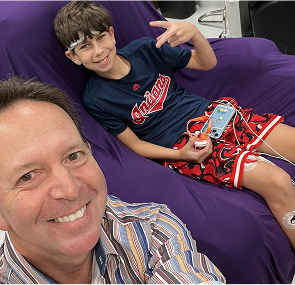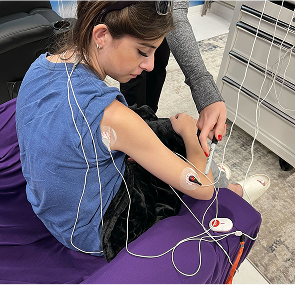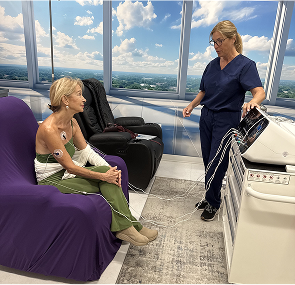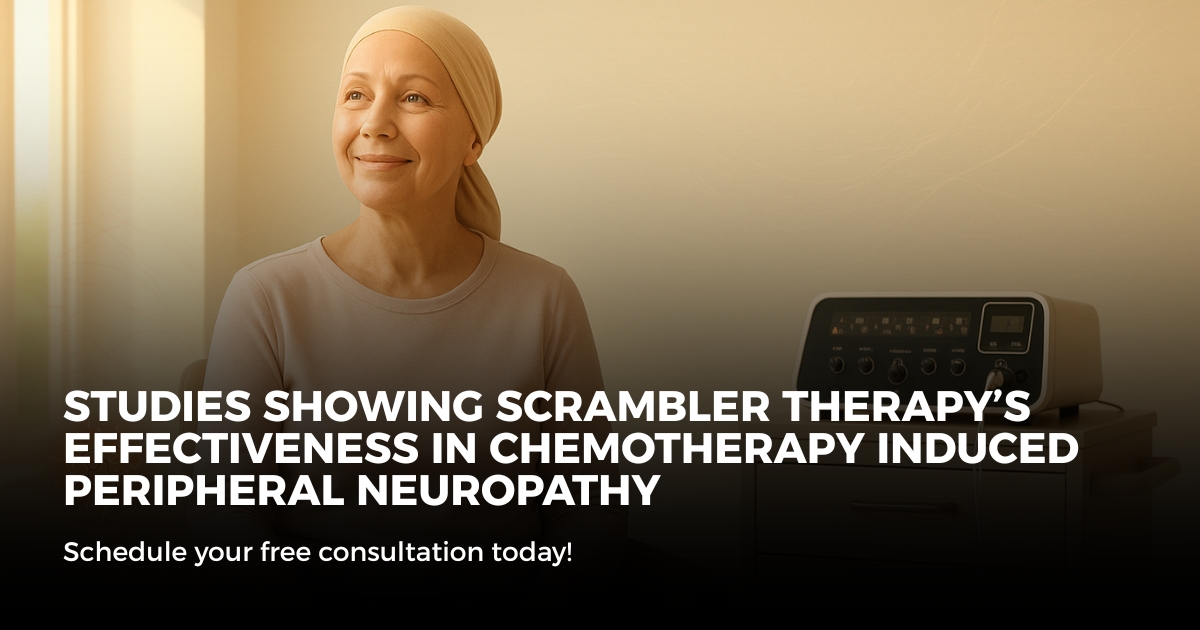Numbness, Burning, Pins and Needles – A New Peripheral Neuropathy Solution

Often starting with burning, tingling, or numbness in the feet, peripheral neuropathy disturbs the lives of millions of people. If you're reading this, chances are you've tried multiple medications—gabapentin, opioids, nerve blocks—yet nothing has delivered lasting relief.
Most conventional treatments merely dull the pain. But when the nervous system keeps misfiring, masking symptoms doesn’t solve the problem. That’s where Scrambler Therapy steps in—a non-invasive, drug-free neuropathy solution that targets the root cause: faulty nerve signaling.
Unlike standard therapies, this FDA-cleared technology retrains the brain to interpret pain signals differently using electrical impulses. It's not a patch. It's not a pill. It's a science-backed breakthrough in neuropathy care.
Next, we’ll help you understand the symptoms of neuropathy to identify if you’re dealing with early-stage nerve dysfunction.
What Are the Early Signs of Peripheral Neuropathy in the Feet and Legs?
Peripheral neuropathy symptoms often start subtly, particularly in the feet and legs, and progress without clear warning signs.
Common Early Indicators:
- Foot numbness or "dead foot" feeling
- Tingling toes or “pins and needles” sensations
- Burning feet, especially at night
- Paresthesia (unexplained abnormal sensations)
- Pain that worsens with touch or temperature changes
These symptoms signal sensory nerve dysfunction. As the condition advances, you may lose balance, coordination, or sensation entirely in the lower extremities. Further nerve misfiring and functional deterioration can be avoided by identifying these symptoms early.
Now that we’ve identified the warning signs, let’s examine why common treatments often fail to deliver long-term relief.
Why Do Traditional Neuropathy Treatments Fail Most People?
Most patients receive gabapentin, pregabalin, or opioids as first-line options for neuropathic pain. These drugs target the central nervous system (CNS) to dull symptoms but never fix the underlying issue: corrupted nerve signals.
Limitations of Traditional Treatments:
- Symptom suppression instead of correction
- Side effects like fatigue, dizziness, or cognitive fog
- Dependency risks and reduced efficacy over time
- Pill fatigue from daily management without results
In some cases, patients undergo surgery, nerve ablations, or spinal cord stimulators—yet still report persistent pain. The issue isn’t the body; it's the brain’s interpretation of pain signals.
The solution? Retraining the nervous system is a better option than trying to numb it.
How Scrambler Therapy Provides a True Peripheral Neuropathy Solution
Scrambler Therapy is a non-pharmaceutical, non-invasive neuropathy treatment using the Calmare® device. Instead of masking pain, it reprograms the brain’s pain response by replacing “pain” messages with “non-pain” ones.
How It Works:
- Sends low-frequency electric signals via electrodes
- Mimics normal nerve communication
- Interrupts maladaptive nerve feedback loops
- Encourages neuroplasticity and sensory remapping
These electrical signals take precedence over the brain's erroneous perceptions of pain. The patient’s own nervous system becomes the therapeutic agent.
This drug-free neuropathy solution has shown long-term benefits for people who thought nothing would work.
Let's now explore how respected institutions back up these claims.
Clinical Evidence from Mayo Clinic and Johns Hopkins
Scrambler Therapy isn’t experimental. It’s backed by top-tier research from leading institutions like Mayo Clinic and Johns Hopkins.
Clinical Highlights:
Patients in these studies reported:
- Improved sleep
- Sustained pain relief
- Reduced dependency on meds
This scientific validation underscores Scrambler Therapy’s reliability. Want to know what the experience is like? Let’s walk through a typical session.
What Happens During a Scrambler Therapy Session?
Visiting South Florida Scrambler Therapy for treatment involves a comfortable, personalized process. Here's what you can expect:
Step-by-Step Experience:
- Consultation: Medical review and pain mapping
- Electrode placement: Electrodes placed on skin near pain area
- Signal calibration: Practitioner adjusts frequency for comfort
- Therapy duration: Sessions last ~60 minutes
- Treatment: 10–12 sessions spread out over two to three weeks
Patients remain fully awake and report a tingling, soothing sensation—not pain. No downtime or sedation is needed. It’s a therapy you feel working in real time.
But why do nerves even produce these distorted signals in the first place?
Why Do Nerves Misfire in Peripheral Neuropathy?
Peripheral neuropathy pain isn't from an injury in the conventional sense. It results from abnormal electrical signals sent by damaged nerves. These signals are misinterpreted as pain, even when there’s no injury.
How Neuropathic Pain Develops:
- Nociceptors misfire without stimulus
- Spinal relay stations amplify false signals
- Brain rewires itself to expect pain chronically
This phenomenon is called maladaptive signaling, and it’s why patients feel burning, tingling, or numbness even at rest. Correcting this miscommunication—without drugs—is the core strength of Scrambler Therapy.
Now, let’s look at who benefits the most from this approach.
Who Is an Ideal Candidate for Scrambler Therapy?
Patients with neuropathies that are resistant to treatment have benefited from scrambler therapy in thousands of cases.
Conditions That Respond Well:
- Diabetic neuropathy
- Chemotherapy-induced neuropathy
- Idiopathic (no known cause) neuropathy
- Post-surgical nerve pain
- Fibromyalgia and CRPS (Complex Regional Pain Syndrome)
Traits of Best Responders:
- Pain present for >3 months
- Failed prior pharmaceutical approaches
- High impact on daily function
Whether your pain stems from nerve trauma, failed back surgery, or chronic nerve signal error, this therapy is often the best treatment for chronic neuropathy without known cause.
Let’s hear from people who’ve experienced it firsthand.
Real Patient Stories: Life After a Neuropathy Breakthrough
At South Florida Scrambler Therapy, patient success is more than anecdotal—it’s consistent.
Real Outcomes Shared:
- One diabetic patient walked unaided for the first time in 3 years
- A cancer survivor reduced burning feet neuropathy by 80%
- A retired nurse regained full sensation in her hands and feet
- Others report sleeping through the night again without medication
Patients often use terms like “life-changing,” “relief I never thought possible,” and “I got my independence back.” These Scrambler Therapy testimonials confirm that long-term relief is achievable.
Still unsure? There are several typical myths that you may be clinging to.
Common Myths About Peripheral Neuropathy Treatments
Top Misconceptions:
- Myth 1: Nerve damage is always permanent
Fact: Many nerve pathways can be reprogrammed - Myth 2: Only medication or surgery helps
Fact: Scrambler Therapy shows comparable outcomes without drugs - Myth 3: It’s probably a placebo
Fact: Double-blind studies eliminate this possibility - Myth 4: Alternative therapies are unproven
Fact: This device is FDA-cleared and clinically validated
These neuropathy treatment myths often block people from exploring real solutions. Understanding facts is key before making a decision.
We answer some of the most frequently asked questions here.
Frequently Asked Questions About Scrambler Therapy
Is it safe?
Yes. It’s FDA-cleared with no significant side effects.
How long until I see results?
Many report relief after 2–3 sessions. The full course is 10–12 sessions.
Does insurance cover it?
Some insurances reimburse partially. Check with your provider.
Is it painful?
No. Most patients find it relaxing and comfortable.
Can I do it at home?
No. Requires clinical expertise and calibrated devices.
Still have questions? The next section shows how to get personalized answers.
Experiencing Chronic Pain in South Florida?

Discover South Florida Scrambler Therapy is one of the nation’s leading clinics for noninvasive chronic pain relief, offering FDA-cleared Scrambler Therapy® for adults and children. Co-founded by Dr. Rick Markson, one of the few practitioners worldwide to receive advanced certification directly from the therapy’s inventor in Rome, our clinic delivers globally recognized expertise with compassionate, personalized care. If you or a loved one is living with treatment-resistant nerve pain, we invite you to schedule a consultation and explore a life beyond pain.
Recommended Reads:
📘 What is scrambler therapy?
📘 What to Expect During a Scrambler Session
📘 CRPS Pain Relief Without Drugs—Real Patient Stories
📘 Conditions that scrambler therapy can treat
Take the Next Step: Free Consultation at South Florida Scrambler

Every day counts when we suffer from chronic pain. South Florida Scrambler Therapy offers a free initial consultation to determine if Scrambler is right for you. Schedule Today:
- Speak directly with Dr. Rick Markson’s team
- Learn about treatment protocols and insurance
- Complete a customized treatment plan
- Start seeing results within days, not months
📞 Call Now or Visit website: www.southfloridascramblertherapy.com
📍 We serve Palm Beach, Fort Lauderdale, and Miami from our location at 100 NW 100th Ave, Plantation
You Can Follow Us through Our Social Media:
📸Instagram—Day-in-the-life stories from our patients
👍Facebook—Success journeys and community support
You deserves to laugh, and enjoy life without pain. The journey starts here.
Start Your Nerve Pain-Free Journey Today






